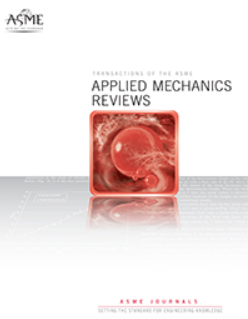A Numerically Efficient Method to Assess the Elastic–Plastic Strain Energy Density of Notched and Imperfective Cast Steel Components
IF 16.1
1区 工程技术
Q1 MECHANICS
引用次数: 0
Abstract
The fatigue strength of cast steel components is severely affected by manufacturing process-based bulk and surface imperfections. As these defect structures possess an arbitrary spatial shape, the utilization of local assessment methods is encouraged to design for service strength. This work applies the elastic–plastic strain energy density concept to study the fatigue strength properties of a high-strength cast steel alloy G12MnMo7-4+QT. A fatigue design limit curve is derived based on non-linear finite element analyses which merges experimental high-cycle fatigue results of unnotched and notched small-scale specimens tested at three different stress ratios into a unique narrow scatter band characterized by a scatter index of 1:TΔW¯(t)=2.43. A comparison to the linear–elastic assessment conducted in a preceding study reveals a significant improvement in prediction accuracy which is assigned to the consideration of the elastic–plastic material behaviour. In order to reduce computational effort, a novel approximation is presented which facilitates the calculation of the elastic–plastic strain energy density based on linear–elastic finite element results and Neuber’s concept. Validation of the assessment framework reveals a satisfying agreement to non-linear simulation results, showing an average root mean square deviation of only approximately eight percent in terms of total strain energy density. In order to study the effect of bulk and surface imperfections on the fatigue strength of cast steel components, defect-afflicted large-scale specimens are assessed by the presented elastic–plastic framework, yielding fatigue strength results which merge into the scatter band of the derived design limit curve. As the conducted fatigue assessment is based solely on linear–elastic two-dimensional simulations, the computational effort is substantially decreased. Within the present study, a reduction of approximately 400 times in computation time is observed. Hence, the established assessment framework presents an engineering-feasible method to evaluate the fatigue life of imperfective cast steel components based on rapid total strain energy density calculations.一种评估缺口和缺陷铸钢构件弹塑性应变能密度的有效数值方法
铸钢构件的疲劳强度受到制造工艺的体积和表面缺陷的严重影响。由于这些缺陷结构具有任意的空间形状,因此鼓励采用局部评估方法进行使用强度设计。本文应用弹塑性应变能密度概念研究了高强度铸钢合金G12MnMo7-4+QT的疲劳强度特性。基于非线性有限元分析,将三种不同应力比下无缺口和有缺口小尺寸试样的高周疲劳试验结果合并为一个独特的窄散射带,其散射指数为1:TΔW¯(t)=2.43,导出了疲劳设计极限曲线。与先前研究中进行的线弹性评估的比较表明,由于考虑了材料的弹塑性行为,预测精度有了显着提高。为了减少计算量,提出了一种新的基于线弹性有限元结果和Neuber概念的弹塑性应变能密度近似方法。评估框架的验证显示了与非线性模拟结果的令人满意的一致性,在总应变能密度方面显示平均均方根偏差仅约为8%。为了研究体缺陷和表面缺陷对铸钢构件疲劳强度的影响,采用本文提出的弹塑性框架对大型铸钢构件进行了疲劳强度评估,得到的疲劳强度结果与导出的设计极限曲线的散射带合并。由于所进行的疲劳评估仅基于线弹性二维模拟,因此大大减少了计算量。在本研究中,计算时间减少了大约400倍。因此,所建立的评估框架为基于快速总应变能密度计算的不完善铸钢构件疲劳寿命评估提供了一种工程可行的方法。
本文章由计算机程序翻译,如有差异,请以英文原文为准。
求助全文
约1分钟内获得全文
求助全文
来源期刊
CiteScore
28.20
自引率
0.70%
发文量
13
审稿时长
>12 weeks
期刊介绍:
Applied Mechanics Reviews (AMR) is an international review journal that serves as a premier venue for dissemination of material across all subdisciplines of applied mechanics and engineering science, including fluid and solid mechanics, heat transfer, dynamics and vibration, and applications.AMR provides an archival repository for state-of-the-art and retrospective survey articles and reviews of research areas and curricular developments. The journal invites commentary on research and education policy in different countries. The journal also invites original tutorial and educational material in applied mechanics targeting non-specialist audiences, including undergraduate and K-12 students.

 求助内容:
求助内容: 应助结果提醒方式:
应助结果提醒方式:


